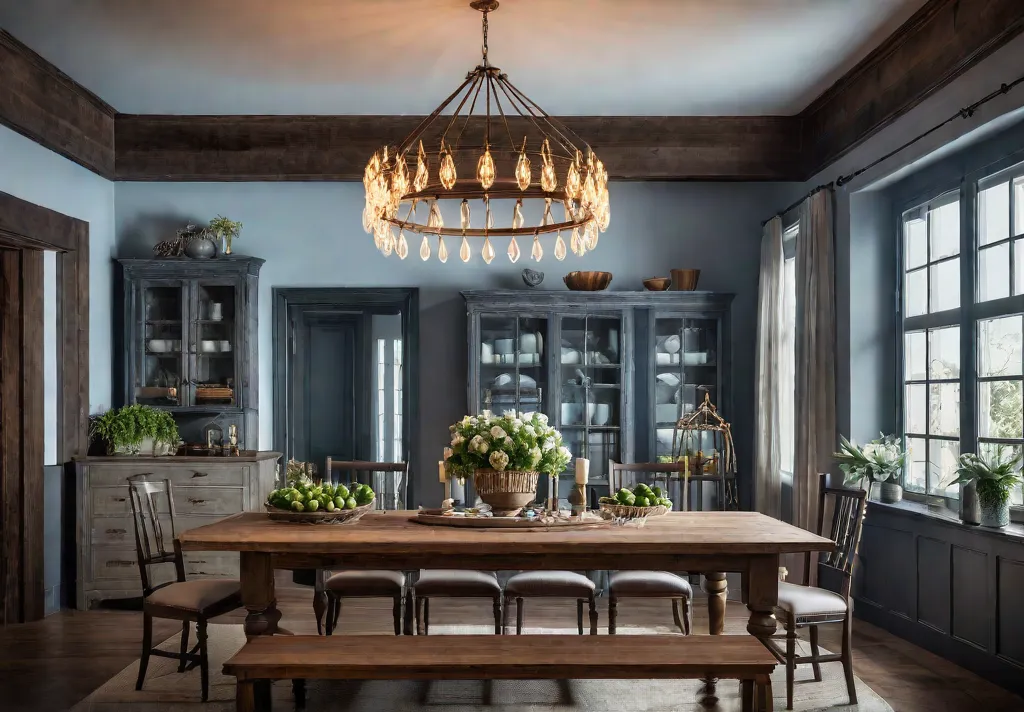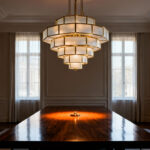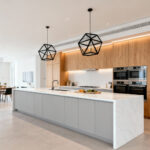Have you ever walked into a room and felt a piece of furniture pull you in? Not just with its design, but with a kind of gravitational force, an invitation to stay. For me, that’s the unmistakable magic of a great farmhouse dining table. It doesn’t just occupy space; it creates a center, a place where stories are destined to unfold over a shared meal.
I spent most of my 20s in a series of generic apartments, where the “dining room” was a corner of the kitchen and the table was an afterthought. It wasn’t until I curated my first small gallery show—and saved up enough from the sales—that I bought my first “real” dining table. It was a rustic, reclaimed wood piece, and I can still remember tracing the faint circular stain left by a farmer’s coffee mug a hundred years ago. That table completely changed the character of my home. It wasn’t just furniture; it was a piece of history, an anchor for my life.

Whether you’re already a devotee of the look or just starting to feel its pull, the farmhouse aesthetic is about so much more than a trend. It’s about connecting with something genuine. It’s an invitation to slow down in a world that never stops moving.
Rustic Farmhouse Dining Tables: A Story in Every Knot
There’s an honesty to a rustic farmhouse table that you just don’t find anywhere else. It feels like a well-loved leather jacket or a worn-in pair of boots—cozy, comfortable, and full of character that was earned, not manufactured.
The soul of this style is a deep, abiding respect for the material itself. We’re often talking about reclaimed wood from old barns or forgotten mills, where every knot, nail hole, and hairline crack tells a story. I once worked with a client who sourced planks from a 19th-century Pennsylvania barn; you could literally see the history etched into the grain. The thick, substantial tops and chunky legs give these tables a sense of permanence, a feeling that they were pulled right from the earth. This isn’t disposable furniture; it’s a future heirloom.

But getting the rustic look right is about more than just the table. Think about texture. This is where you can start layering in other raw, organic materials. I’ve seen wrought iron bases, hammered copper accents, and even stone inlays used to add incredible depth. Pair that rugged table with a bench or vintage chairs whose upholstery is just slightly distressed. The goal is to create a harmonious space that feels lived-in, not just decorated. Don’t be afraid to add plants, hand-thrown pottery, or a simple woven runner to complete that feeling.
Modern Farmhouse Dining Tables: Where Clean Lines and Country Warmth Collide
Now, what if you love that warmth but your personal aesthetic leans more contemporary? This is where the modern farmhouse style truly shines. It’s a beautiful balancing act, an aesthetic conversation between rustic soul and refined, minimalist design. It’s for the person who wants to host both a cozy Sunday brunch and a sophisticated dinner party.
At first glance, a modern farmhouse table feels cleaner, more streamlined. The lines are crisp and the silhouettes are less fussy. But look closer, and you’ll find the farmhouse DNA. You might see a beautifully finished reclaimed wood top, but it’s paired with sleek, slender steel legs that almost disappear, making the wood appear to float. That tension between the raw and the refined is what makes it so visually exciting.

One of the defining features here is that artful mix of materials. I’ve seen thick, solid oak tops set on minimalist trestle bases that echo the form of old farm equipment but are rendered in clean, contemporary metal. Or imagine a polished concrete surface—something quite stark on its own—completely softened by the introduction of classic Windsor chairs painted in a moody, modern hue. Feel free to be a bit bolder with your lighting choices here, too. A dramatic, modern chandelier or a simple cluster of pendant lights can provide a perfect counterpoint to the table’s rustic elements.
Traditional Farmhouse Dining Tables: The Enduring Comfort of a Classic
For many, the word “farmhouse” immediately brings to mind visions of sprawling family dinners and well-loved heirlooms passed down through generations. If that’s you, then a traditional farmhouse table is your aesthetic soulmate. These pieces are all about timeless comfort, evoking a sense of rural simplicity and nostalgia that honestly never feels dated.
At its heart, the traditional style celebrates classic craftsmanship and the natural beauty of wood. You’ll notice details that have been part of furniture making for centuries, like gracefully turned legs, detailed aprons (the wooden panel connecting the top to the legs), and solid, dependable construction. These are nods to a time when furniture was built to withstand everything life could throw at it.

Trestle and pedestal bases are common here—design choices that were originally about function in old homes but have become cherished design elements today. Can’t you just picture a long trestle table, flanked by a pair of matching benches, ready for a loud, happy holiday meal? To really lean into this look, think about soft, cozy textures. A simple linen runner, woven placemats, and a centerpiece of fresh-cut flowers or seasonal branches add warmth. And if you have space, a vintage-inspired hutch filled with your favorite dishes completes the picture perfectly.
Industrial Farmhouse Dining Tables: A Bold and Beautiful Contradiction
If your taste runs a little more eclectic and you’re not afraid to make a statement, you need to look at the industrial farmhouse style. This is where things get really interesting. These tables are bold and unexpected, blending the raw, utilitarian feel of a factory with the organic warmth of a farmhouse. The result is an edgy, compelling look that still feels incredibly inviting.
Let’s be honest: on paper, it sounds like a contradiction. The cool, hard lines of metal meeting the warm, weathered grain of wood. But that very clash is what creates the magic. It’s a fusion of rugged and refined that immediately draws you in and starts a conversation. At a recent design fair, I saw a table made from a single, massive slab of salvaged bowling alley lane, set on a raw steel I-beam base. It was stunning. Unforgettable.

You’ll see a lot of surprising materials at play. Thick wood tops might be held up by cast iron machine legs, or weathered planks could be framed with riveted steel. To make this work in your home, lean into the eclectic vibe. Pair your table with sleek, modern Eames-style chairs or a set of vintage metal stools from an old diner. Exposed bulb pendant lights are a classic choice, and layering in other metal accents like wire baskets or galvanized planters will tie the whole room together.
Scandinavian Farmhouse Dining Tables: The Beauty of Minimalist Warmth
Is clutter your mortal enemy? Does an open, light-filled space make your heart sing? If so, the Scandinavian farmhouse style might just be the breath of fresh air you’ve been searching for. This is the minimalist’s interpretation of farmhouse—serene and uncluttered, blending clean lines and airy aesthetics with just the right amount of rustic texture.
The guiding principle of Scandi design is a deep love for natural materials, simplicity, and light. These tables often feature pale woods like white oak, ash, or pine, sometimes with a simple whitewashed or soap finish. The goal is to create a feeling of tranquility and openness that feels incredibly calming and perfectly suited for modern life. A gallery wall of simple black and white photos or abstract prints on a crisp white wall is the perfect backdrop.

But minimalist absolutely does not mean boring. Scandinavian design is all about subtle, thoughtful craftsmanship. A gently curved trestle base, the faintest hint of distressing on a painted finish, or an elegant bit of inlay can add just enough character to draw you in without overwhelming the space. To get this vibe, keep the whole room light. Pair your table with iconic chair designs—like Hans Wegner’s Wishbone chair—and incorporate natural textiles like linen and wool. It’s about creating a quiet oasis where you can truly slow down.
French Country Farmhouse Dining Tables: A Touch of Rustic Elegance
If you find yourself daydreaming of a vacation home in Provence, surrounded by lavender fields and old stone walls, then the French country farmhouse table can bring a piece of that dream into your home. These tables exude a sophisticated, refined elegance while still feeling deeply rooted in a rustic, countryside charm.
What sets the French country style apart is its embrace of graceful, decorative details. The legs are often ornately turned or cabriole (a gentle S-curve), and you might see intricate carvings or scalloped aprons. It’s a touch more romantic, a bit more whimsical, than its American farmhouse cousin.

But the key here is balance. The best French country pieces avoid feeling stuffy by pairing that elegance with rustic finishes. Think lighter, whitewashed wood tones with a distressed patina that hints at a long and well-loved life. To really capture this aesthetic, think about your chairs and accents. Chairs upholstered in classic toile or a soft floral fabric are a perfect match. A vintage-inspired crystal chandelier, lace-trimmed linens, and antique pottery will transport you to the French countryside, no matter where you live.
Blending Farmhouse Styles: The Curator’s Approach
Here’s where it gets really personal and creative. While each of these styles has a clear point of view, some of the most compelling and personal dining spaces I’ve ever seen are born from a thoughtful fusion of multiple aesthetics. Who says you have to choose just one?
Think about the visual energy you could create by pairing a truly rugged, rustic table with a set of sleek, modern ghost chairs. That contrast between the weathered wood and the transparent acrylic is dynamic and keeps the eye moving. I once advised a client to do just that in their open-concept loft, and the table became a stunning piece of functional sculpture.

Or maybe you’re pulled in by the bold, edgy look of an industrial table but worry it will feel too cold. This is where you can layer in softer, traditional farmhouse elements. A set of upholstered chairs, a beautiful antique rug underneath, or some warm, vintage-inspired lighting can balance the look and create a space that feels both curated and deeply comfortable. The trick to blending styles successfully is to find a common thread. It might be a shared color palette, a repeated material, or a similar scale. Trust your eye, experiment, and don’t be afraid to create a room that is uniquely, unapologetically you.
Bringing Farmhouse Charm into Modern Living
As the farmhouse look continues to evolve, people are finding amazing ways to integrate these pieces into totally modern homes. The result is a beautiful blend of rustic character and contemporary sophistication that feels both grounded and fresh.
Perhaps you live in a minimalist, open-concept home but fall in love with the soul of a traditional farmhouse table. Go for it! You can bridge the two worlds by surrounding the table with sleek, modern chairs or hanging a sharp, architectural light fixture above it. This single point of contrast makes both the table and the modern elements feel more intentional.

Or, let’s flip it. Maybe you’re in a cozy urban apartment and have your heart set on an industrial-style table. To keep it from overpowering the space, you can soften it. Bring in lots of plush textiles, scatter potted plants around, and use organic, rounded shapes in your decor to balance out the hard lines of the table. The beauty of this design moment is its flexibility. It’s all about creating a space that reflects how we actually live today—connected to history, but firmly in the present.
A Table for Every Story
So, as you can see, “farmhouse” isn’t one single thing. It’s a whole universe of styles, each with its own personality and charm. From weathered and rustic to streamlined and modern, there is a farmhouse table out there that is a perfect fit for your home and the life you want to build within it.

I encourage you to embrace the warmth and character these pieces offer. In my experience, both as a curator and just as a person, the most important moments of our lives tend to happen around a table. It’s where late-night conversations unfold, where families gather and grow, where you have a quiet moment to yourself with a morning coffee.
Your dining table is so much more than a place to eat. It’s the centerpiece of your home’s story, a canvas for memories, and a beautiful, daily reminder to savor the simple things. So find the one that speaks to you. Find the one that feels like home.






